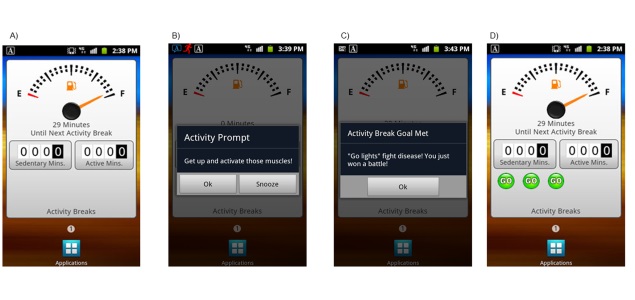New Smartphone App to Help Reduce Sedentary Behaviour

More sedentary time, regardless of physical activity levels, is associated with greater risk for obesity, cardiovascular disease and mortality.
The smartphone-based intervention method, developed by researchers at The Miriam Hospital in the US, can produce short-term reductions in sedentary behavior that may be effective in improving health.
Dale Bond and Graham Thomas lead researchers and faculty in the Department of Psychiatry and Human Behavior at The Miriam Hospital's Weight Control and Diabetes Research Center, working with their colleagues to develop a smartphone app to reduce the amount of time individuals sit or recline while awake.
The smartphone app, "B-Mobile," was tested in a study of primarily middle-aged women who were obese, although the intervention can be applied to those who are not obese.
The app automatically monitored the time participants spent being sedentary, and after an extended period with no activity, prompted participants via a tone paired with motivational messages to get up and walk around for a few minutes.
Participants received feedback providing encouragement for taking a break and reinforcement when they achieved the walking break goal.
Researchers tested three different approaches to see which was best at reducing the total amount of sedentary time. Even though all three were successful, researchers found it is better to take shorter breaks more often for better health.
Also, while previous interventions have used similar behavioral strategies such as self-monitoring and feedback to reduce sedentary behavior, use of a smartphone allowed these strategies to be easily automated and implemented through the day in any environment, researchers said.
The app performed better than other low-intensity intervention approaches that do not involve intensive face-to-face contact and/or expensive equipment.
"Prompting frequent, short activity breaks may be the most effective way to decrease excessive sedentary time and increase physical activity in individuals who are overweight or obese," Bond concluded.
The findings of the study are published in PLOS ONE.
Get your daily dose of tech news, reviews, and insights, in under 80 characters on Gadgets 360 Turbo. Connect with fellow tech lovers on our Forum. Follow us on X, Facebook, WhatsApp, Threads and Google News for instant updates. Catch all the action on our YouTube channel.
Related Stories
- Samsung Galaxy Unpacked 2025
- ChatGPT
- Redmi Note 14 Pro+
- iPhone 16
- Apple Vision Pro
- Oneplus 12
- OnePlus Nord CE 3 Lite 5G
- iPhone 13
- Xiaomi 14 Pro
- Oppo Find N3
- Tecno Spark Go (2023)
- Realme V30
- Best Phones Under 25000
- Samsung Galaxy S24 Series
- Cryptocurrency
- iQoo 12
- Samsung Galaxy S24 Ultra
- Giottus
- Samsung Galaxy Z Flip 5
- Apple 'Scary Fast'
- Housefull 5
- GoPro Hero 12 Black Review
- Invincible Season 2
- JioGlass
- HD Ready TV
- Laptop Under 50000
- Smartwatch Under 10000
- Latest Mobile Phones
- Compare Phones
- Jolla Phone
- Realme P4x 5G
- OnePlus Ace 6T
- Nubia Flip 3
- Nubia Fold
- OPPO A6x 5G
- Samsung Galaxy Z TriFold
- Poco F8 Ultra
- Asus ProArt P16
- MacBook Pro 14-inch (M5, 2025)
- OnePlus Pad Go 2
- Poco Pad M1
- Just Corseca Skywatch Pro
- Honor Watch X5
- Acerpure Nitro Z Series 100-inch QLED TV
- Samsung 43 Inch LED Ultra HD (4K) Smart TV (UA43UE81AFULXL)
- Asus ROG Ally
- Nintendo Switch Lite
- Haier 1.6 Ton 5 Star Inverter Split AC (HSU19G-MZAID5BN-INV)
- Haier 1.6 Ton 5 Star Inverter Split AC (HSU19G-MZAIM5BN-INV)

















